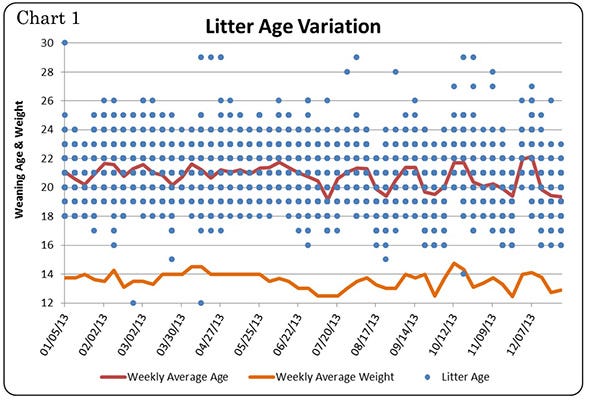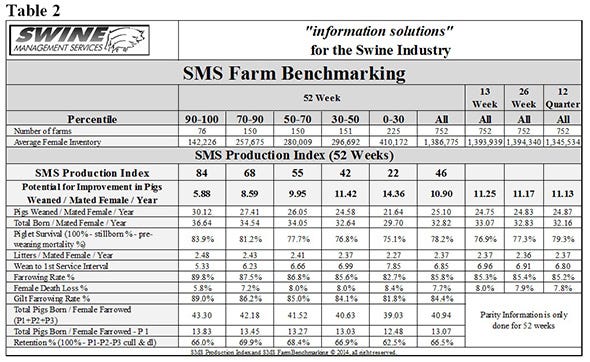August 4, 2014

In last month’s column “Is There A Sweet Spot for Weaning Age?”, in the data set of 629 farms, the top 10% farms had an average weaning age of 19.88 days,the bottom 30% were at 20.74 days with all farms achieving an average of 20.46 days with a range of 14.83 to 28.42 days.
These farms had a range of 20.11 to 34.01 pigs weaned per mated female. After the article, we were asked, "Have you ever looked at weekly range in weaning age of pigs by farm?" A consultant for the industry sent us some data from a farm that was broken out by weaning age spread on a weekly basis. We did look at the data, and were surprised to see so much variation in weaning age of pigs.
To see if this large variation in weaning age was real, we selected one of the farms we work with that we feel is well managed. In Chart 1: Litter Age Variation is data for this farm for 2013 broken out by weeks on the X-axis and weaning age and weight on the Y-axis. The Weekly Average Age (red line) shows some variation in weaning age week-to-week, however, the range by litter as shown by the blue dots is big with a range of 12 to 30 days in weaning age. We know that some of the extreme lows and highs may be a data entry issue and some of these pigs may have been placed on a nurse sow, because this is the real world. 
When you send out a good load of weaned pigs with weaning weight of 14 pounds, and get the grading sheet back to see 2% of the pigs were less than 8.5 pounds and according to the contract are rejects, you’re disappointed. If that was a load of 1,200 pigs valued at $75 per pig, you just lost $1,800 on that load of pigs. Were these pigs smaller due to low birth weight, raised on a gilt litter or just weaned young?
If you would have maintained ownership of the pigs that are now going into the nursery and after sorting the pigs you have one or two pens of small pigs, what do you do with them? You know you should be feeding these pigs some high cost starters and know that most of the deaths and culls may come out of these pigs. So why were these pigs weaned? We know that after a porcine reproductive and respiratory syndrome (PRRS) virus or porcine epidemic diarrhea virus (PEDV) break, there is no sorting of pigs after 24 hours, or forming of a nurse litter or moving pigs back a few days that you will be weaning more lightweight pigs. So why are all these small pigs being weaned in farms not dealing with a health challenge?
To look at the variation in weaning age among farms, we selected 22 farms with average weaning age between 19 and 20 days over the last three years. These farms had 43,032 females and 241,597 weanings. With twice-a-week weaning, the target would be for all pigs to be weaned within four days of age. These farms had not been dealing with any major health challenges. Table 1 shows that only 58.4% of the litters are within the target range of 18 to 21 days, 18.5% are 17 days and lower and 23.1% are 22 days and older. We estimated weaning by age with 14 pounds at 20 days as the base. The average weaning weight for these pigs would be 13.85 pounds. The problem arises with 18.5% of the pigs being less than 12 pounds. Chart 2, “Percent Weaned vs Weaning Age,” has weaning age on the X-axis and percent weaned on the Y-axis showing you the large variation of these 22 farms in weaning age.

So what can you do to lower the week-to-week variation in weaning age or smaller pigs being weaned?
Start loading sows into farrowing by previous gestation length versus do to farrow date. This will help reduce the length of time this room will farrow. We know that gestation length is repeatable. This works in farms doing minimal inducing.
Moving some litters after farrowing to a room with litters that are the same age. This is possible if your farm is not dealing with a health challenge.
Evaluating litters to be weaned the day before weaning and mark the litters that are not to be weaned. We know that on weaning day mistakes can happen with all the activity going on.
Evaluating pigs at birth and consider euthanizing pigs that are less than 1.50 pounds at birth. Data shows that less than 25% of these pigs will make it to weaning. This allows bigger pigs more access to colostrum and a chance to be heavier at weaning.
It may be time to run some reports on your farm to see if weaning age is causing the small pigs at weaning. You may need to make some changes in weaning day procedures or how sows are loaded into the farrowing rooms to tighten up the weekly weaning age. This can mean some big dollars to the farm.
At Swine Management Services, our mission statement is to provide “Information solutions for the swine industry”. We feel with the creation of the new Farm Benchmarking database we now have more detailed information to share with the swine industry. If your farm would like to be part of the Farm Benchmarking database, or if you have suggestions on production areas to look at, feel free to e-mail or call us.
SMS Production Index
Table 2 provides the 52-week rolling averages for 11 production numbers represented in the SMS Production Index. The numbers are separated by 90 to 100%, the 70 to 90%, the 50 to 70%, the 30 to 50% and the zero to 30% groups. We also included the 13-week, 26-week and 12-quarter averages. These numbers represent what we feel are the key production numbers to look at to evaluate the farm’s performance.
Previous Production Preview columns can be found at www.nationalhogfarmer.com.
If you have questions or comments about these columns, or if you have a specific performance measurement that you would like us to write about, contact [email protected] or [email protected].
You May Also Like



